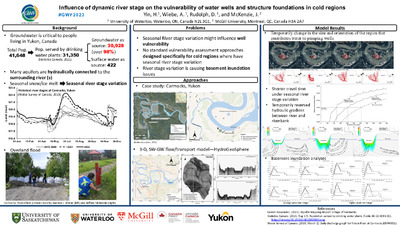| dc.contributor.author | Yin, Haoyu | |
| dc.contributor.author | Wiebe, Andrew James | |
| dc.contributor.author | Rudolph, David L. | |
| dc.contributor.author | McKenzie, Jeffrey | |
| dc.contributor.author | Yin, Haoyu | |
| dc.date.accessioned | 2023-06-15 19:15:35 (GMT) | |
| dc.date.available | 2023-06-15 19:15:35 (GMT) | |
| dc.date.issued | 2023-05-15 | |
| dc.identifier.uri | http://hdl.handle.net/10012/19542 | |
| dc.description | This research was undertaken thanks, in part, with support from the Global Water Futures Program funded by the Canada First Research Excellence Fund (CFREF) | en |
| dc.description.abstract | Groundwater is important for people in Northern Canada, yet the groundwater protection protocols and water well vulnerability assessments designed for other warmer regions of Canada may not be applicable to communities in Northern Canada due to the unique hydrogeological characteristics there. The seasonal melt of snow and ice leads to intense river stage fluctuations and might cause flood issues to the adjacent floodplain; however, their influences on the vulnerability of drinking water wells and nearby infrastructure are not fully understood. This research considers a case study at Carmacks, central Yukon, where an integrated surface-subsurface numerical modelling code was used to examine these processes. The model results indicate that the annual variation in the river stage temporarily reverses the direction of the hydraulic gradient between the surface water body and the adjacent aquifer. Stream reaches that gain groundwater under lower river stages can become losing streams during the high stage periods, which facilitates the transport of solute from the river to the adjacent aquifer. Additionally, the model shows that the annual river stage variation can temporarily alter the size and orientation of the region that contributes water to pumping wells, which means new environmental threats could become important. In terms of travel time, the model results suggest that annual river stage variation accelerates the transport of river-origin solutes to the adjacent aquifer, and higher river peaks facilitate more rapid solute migration. Thus, the natural protection of the soil travel path against microbial pathogens may become inefficient and water wells may become more vulnerable. The model results also demonstrate that higher peak river stages are more likely to cause basement inundation at buildings on the riverbank than an average peaks, and that the duration of basement inundation varies at different locations. | en |
| dc.description.sponsorship | Engineering Research Council of Canada (NSERC) || Government of Yukon || Global Water Futures (Canada First Research Excellence Fund) | en |
| dc.language.iso | en | en |
| dc.publisher | University of Waterloo | en |
| dc.relation.ispartofseries | Global Water Futures; | |
| dc.subject | GWF ASOM 2023 | en |
| dc.subject | well vulnerability | en |
| dc.subject | cold region | en |
| dc.subject | numerical model | en |
| dc.subject | river stage fluctuation | en |
| dc.subject | river-connected aquifer | en |
| dc.title | Influence of dynamic river stage on the vulnerability of water wells and structure foundations in cold regions | en |
| dc.type | Conference Poster | en |
| dcterms.bibliographicCitation | Yin, H; Wiebe, A; Rudolph, D & McKenzie, J. (2023). Influence of dynamic river stage on the vulnerability of water wells and structure foundations in cold regions. Global Water Futures (GWF) Annual Open Science Meeting. University of Waterloo. | en |
| uws.contributor.affiliation1 | Faculty of Science | en |
| uws.contributor.affiliation2 | Earth and Environmental Sciences | en |
| uws.typeOfResource | Text | en |
| uws.peerReviewStatus | Unreviewed | en |
| uws.scholarLevel | Graduate | en |

